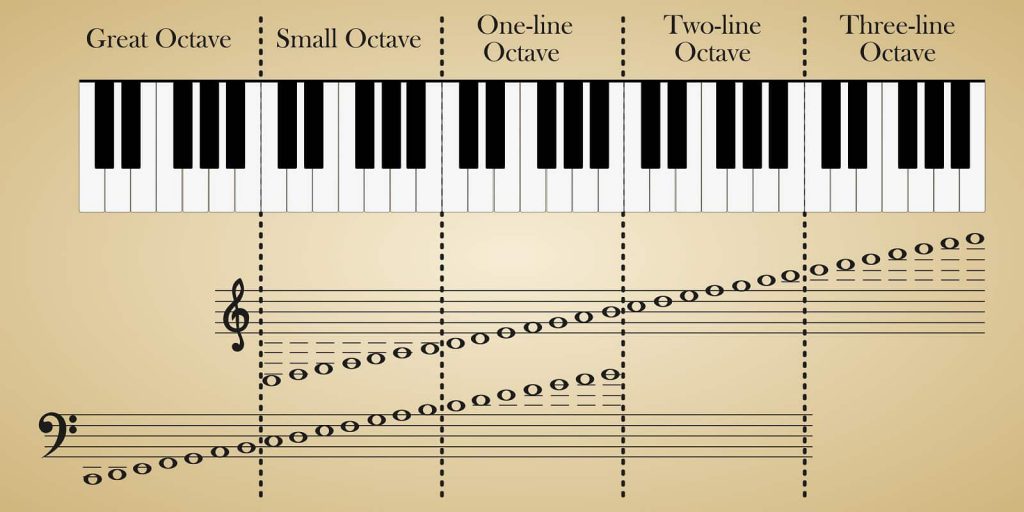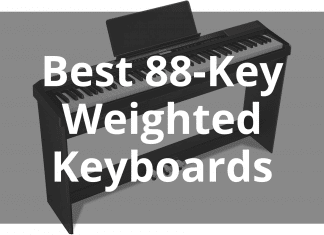A piano is a beautiful instrument that people have enjoyed for centuries. Throughout history, the standard number of keys has changed. Though many pianos vary in key quantity, most of them have a set number. You may have wondered, “How many octaves does a piano have?” This article will go through everything you need to know about piano keys.
How Many Keys on a Piano?
A full-sized piano has 88 keys. Out of them, 52 are white, and 36 are black. The white keys consist of the notes C, D, E, F, G, A, and B. The black notes make up the sharps and flats. For example, F-sharp is also classified as G-flat. Why does there have to be both sharps and flats? The answer is this: It’s better to use sharps in some instances and flats in others. For example, if the key of a song is D major, the F# is the right way to spell it. Otherwise, the scale would be D, E, Gb, G, etc. By using Gb, you completely skip F, which is wrong.
How Many Octaves on a Piano?
On an 88-key piano, there are 7 octaves. If you count the black keys, each octave consists of 12 notes. If you’re just looking at the white keys, an octave is 8 keys. However, there are only 7 different notes. The 8th note is the octave, which is the same as the first note. Many people are intimidated by the number of keys on the piano. But, if they knew that it only has 12 different notes, their perspectives might change.

You might wonder, “Why do keyboards have varying numbers of keys?” The two main reasons companies create smaller keyboards are to have a budget-friendly or specialized product.
Keyboards with fewer keys tend to be less expensive and more reasonable for the average household. However, some people prefer a lower number of keys for music production reasons. MIDI keyboards are perfect for home studios, as they’re lightweight, portable, and powerful.
There are a few exceptions to conventional 88-key pianos. Bosendorfer is a renowned company that makes pianos with extra keys. Most pianists use these keys to add richness to chords rather than playing them by themselves.
The history of this company is interesting. In 1828, Ignaz Bosendorfer created the first model of his piano. At the time, Liszt, a famous pianist, was tearing up the music scene. He was the equivalent of today’s Justin Bieber or Bruno Mars. His animated performance style tended to break many pianos. Liszt tested the Bosendorfer and couldn’t break it, no matter what he did. From that moment, he only played Bosendorfer pianos. Since then, Bosendorfer has remained a top-selling piano company. If you want to get your hands on a 97-key piano, you’ll have to pay anywhere between $250,000 to $500,000.
History of Piano Keys
Before the invention of the piano, there was the Harpsichord. This instrument had 60 keys, with one string per key. Around the year 1700, Bartolomeo Cristofori created the first piano. It had only 54 keys, and was very different from today’s pianos. For over 100 years, pianos continued to have a limited number of keys. As time went by, composers were writing music outside of the range. It wasn’t until the 1890s when all pianos started having 88 keys.
Why Do Pianos Only Have 88 Keys?
Pianos have 88 keys because of our ears. We can hear frequencies between 20 Hz and 20 kHz. The range of a piano is 27.5 Hz to 4186 Hz. Keys below this frequency become muddy and less pleasant to hear. On the other hand, the keys above the range become harsh-sounding.
An Australian company called Stuart & Sons created a piano with an astounding 108 keys. This piano is called The Beleura, and it’s the largest piano in the world. Since frequencies outside the normal range are less appealing, it’s up to you to decide whether this 108-key keyboard is worth it.
Conclusion
So, if you’ve ever wondered, “How many octaves does a piano have?”, now you know the answer. With 7 and 1/4th octaves, a piano is a highly versatile instrument. There aren’t many instruments with the same range and expressive possibilities. Some people prefer keyboards with fewer keys, and others prefer the extra keys of a Bosendorfer. If you’re striving to become an excellent pianist, it’s best to go with a 7-octave, 88-key piano. Any less than that, and you have a great keyboard for a home studio. Now, you know how many octaves on a piano.
Table of Contents










